It’s common to think of confidence as a natural byproduct of success—as if only successful people deserve to be confident in their abilities, and the folks who make mistakes should be left behind. But the reality is that everyone fails at everything before they succeed, successful people included. And sometimes, they even fail while succeeding, but they don’t let their mistakes hold them back from moving forward.
The illusion of Instagram.
One of my favorite ways to connect with fellow sewing-enthusiasts is via Instagram. There, I get to learn from others as well as share my experiences and techniques I’ve learned over the years. I try to be intentional about sharing my process because it’s important for people to see that even experienced sewists make mistakes. I often get messages from those who are following along who are thankful that I share when I mess up and how I fixed it. This is the kind of feedback that makes me feel the most valued.
But I’ve noticed that my posts that show a garment in-process tend to get less engagement, fewer comments, and fewer likes than the edited photos of myself posed in a finished garment. While in the big picture, likes and engagement don’t really matter, I use this example to illustrate the discrepancy between what people actually value seeing (the process, the mistakes, the solutions) and what people instinctively react positively to (a pretty picture, a pop of color, a balanced composition).
Our society has a focus on finished products—if it’s not finished, it’s not worth sharing. It’s easy to compare yourself to others, especially when all you see are the successful garments. But don’t let comparison be the thief of joy; we all have in-process moments. It takes vulnerability to share something outside of its final state and to say, “this is an idea I have that I’m pursuing to the best of my ability.” And if that finished garment doesn’t live up to the garment you designed in your head, it’s important to remember that mistakes are just part of the iterative process.
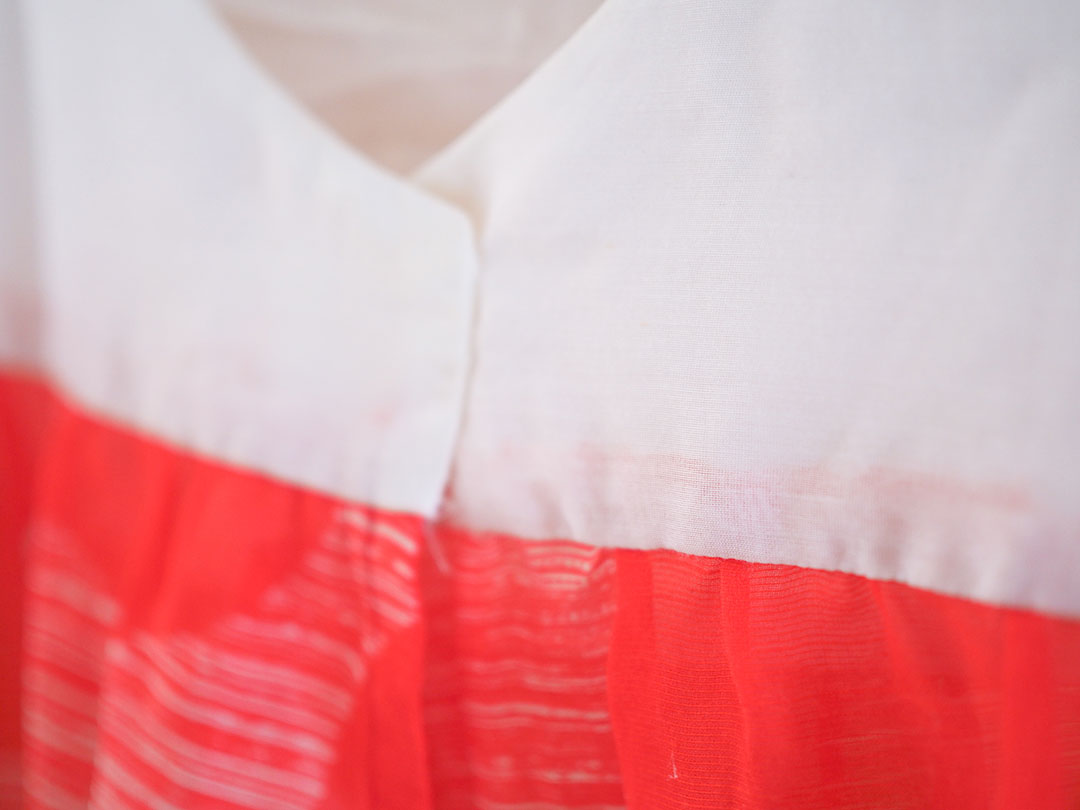
I enclosed a red seam inside a sheer white voile without realizing the bright red would show through the white fabric. It gives it a homemade vibe, but I love it anyway.
Sewing as an iterative process
When I first met my husband, he was surprised to learn that I didn’t make a single pattern more than a couple of times. As an engineer, he knew the value of the iterative process. It basically calls for repeatedly making the same object with various tweaks until it’s as close to perfect as possible.
I think it came as a shock to him that, outside of the rare muslin, there was no “rough draft” version of my finished product. On the flip side, I was shocked to learn that anybody had the patience to make the same thing over and over again. Unless I was making my wedding gown, there was no way I was going to make several versions of the same pattern to try to get that perfect fit.
When some part of my sewing project wasn’t cooperating, and I would start on a mild spiral of despair, he’d comfort me by gently reminding me that these aren’t going to be the last pair of pants I sew and I can fix the issue on the next pair.
The iterative process lets us fail better. When we look at failure as just an iteration before we make a tweak, it makes mistakes look a whole lot more inviting.
When I connected the dots, I realized that sewing, in and of itself, is an iterative process. It wasn’t a single garment or pattern that I was repeating, tweaking, and making better the next time. It was that every seam I sewed was, on average, better—or faster or cleaner or straighter—than the last. Every time I installed a zipper, shirred fabric, sewed a French seam, or hemmed pants, I learned something and developed my muscle memory. And even if it’s a whole year before I shirr fabric again, my next iteration will have the benefit of me having experienced it before.
The iterative process lets us fail better. When we look at failure as just an iteration before we make a tweak, it makes mistakes look a whole lot more inviting.
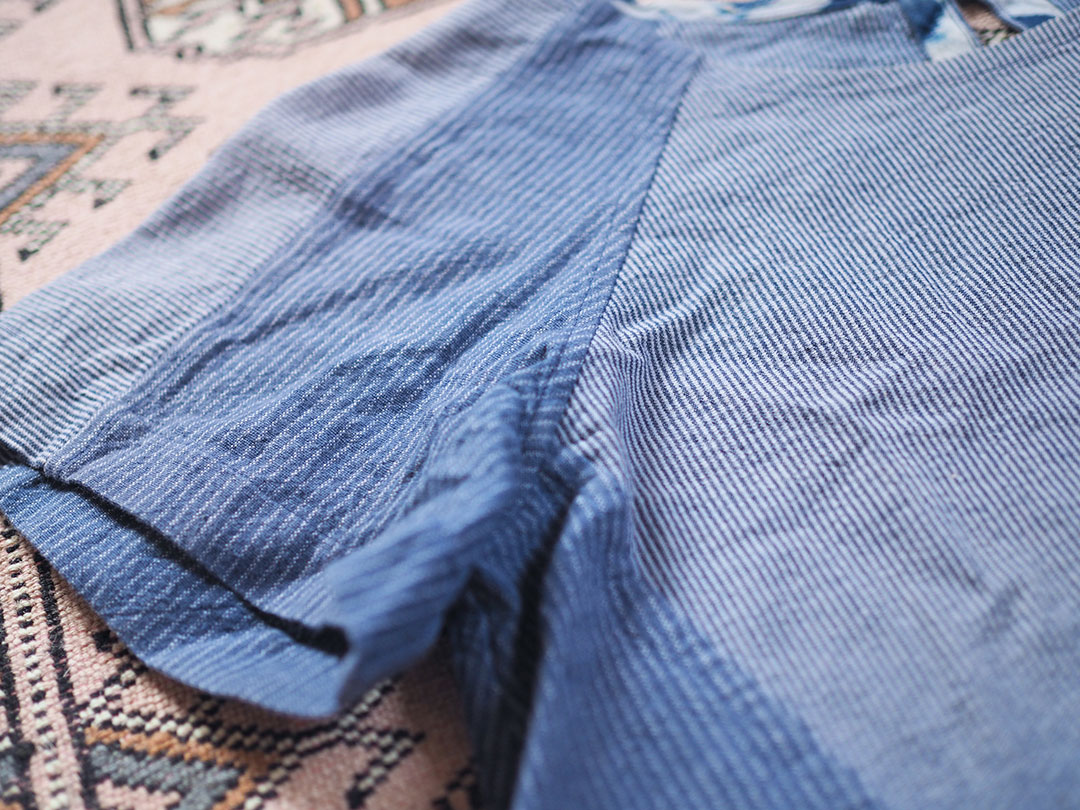
I pre-washed these railroad denim stripes with an indigo-dyed cotton, which turned the white stripes blue. I used the fabric anyway.
When do you practice sewing?
In yogic culture, doing yoga is commonly referred to as a yoga practice, and I really like this kind of terminology in how it relates to doing our self-care hobbies. The word practice implies that we’re on a journey to get better at whatever it is we’re practicing.
Even mentally referring to our time spent sewing as a sewing practice can free us from the expectations that arise when we think of our sewing as a performance—because sewing is not a performance, right? It may seem like it sometimes because of the way we parade and peacock our finished garments on social media, but one wonky seam doesn’t reflect the entire body of work we’ve ever created.
We sew because it sets us free, makes our hearts sing, and releases all those happy chemicals in our brains that come from being productive—from producing something with our bare hands. And we practice at it because when we do, we’re experiencing the journey of improvement.
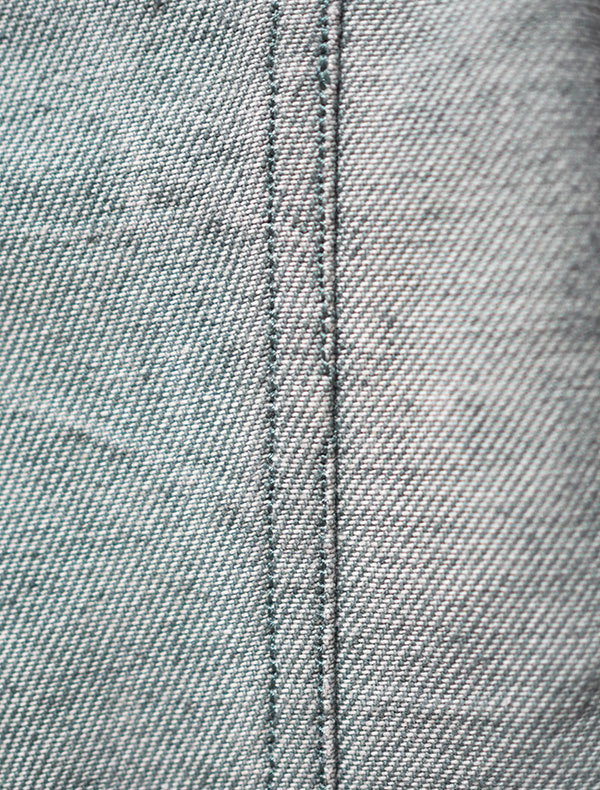
Sometimes, our mistakes aren’t worth fixing, like this wonky topstitching on the inner side of a pant leg.
Show yourself compassion
Just as sewing is a practice, patience is a muscle—it takes repetition and exercise to strengthen it. No one is born with an innate ability to make perfect garments. The secret to developing any skill is to be patient with yourself and to allow yourself to mess up without judgment. Don’t gatekeep yourself from doing the thing you enjoy doing just because you falsely believe you aren’t good enough.
When I make a fixable mistake, I let myself have a big sigh if I need it, and then I remind myself that I’m only as good as I am willing to go back and fix my mistake. My drive to do better is usually the motivating factor in spending time fixing a botched seam, even if sometimes it feels like I’m moving backward.
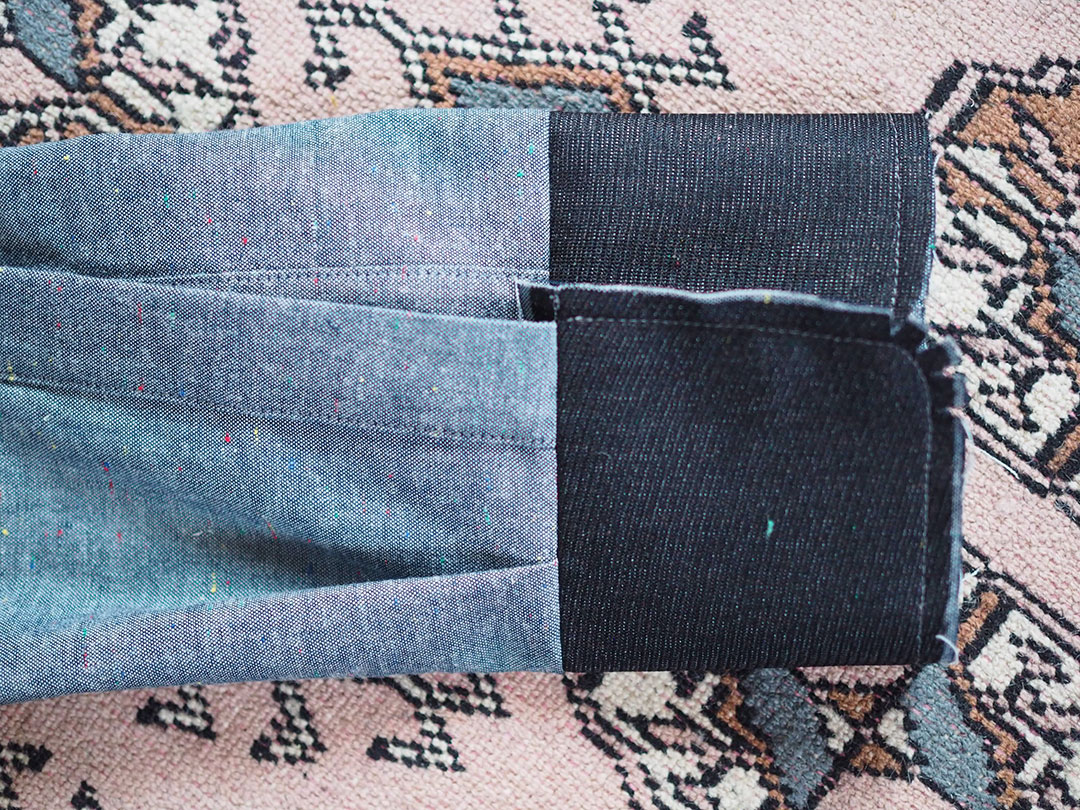
Other times, you can’t move forward without fixing your mistakes. Here, I sewed a sleeve cuff on inside out.
Mistakes are a feature, not a flaw.
Without mistakes, how could you ever learn boundaries? In Germany, we have a theory in raising children that they should be allowed to make mistakes—even to hurt themselves sometimes—because they need to learn their own boundaries. In regards to sewing and garment construction, I think of these boundaries as the properties, limitations, and strengths of certain fabrics and how that can affect the final garment.
When I first started to make clothing, here are some mistakes I made.
- Added power mesh ruffles to the bottom of a silky poly dress. I didn’t know that power mesh would be too heavy and weigh the whole skirt down.
- Made a messenger-style bag out of sweatshirt fleece with a straight stitch, including the strap. I didn’t realize that the weight of the bag would stretch out the knit strap, so the bag hung at my knees.
- Ironed a polyester prom dress I was making for a friend with too high of a heat setting and melted a hole in the center front. I glued beads over it to cover the hole.
- Sewed a pencil skirt with no zipper and no elastic, so the skirt just rested precariously on my hips. I was constantly pulling that skirt up.
Every time I messed up, I learned the properties of the fibers I was working with at the cost of sacrificing that fabric to the sewing gods. But I needed to make these mistakes to learn about them. We all need to make that proverbial dress out of quilting cotton in order to learn.
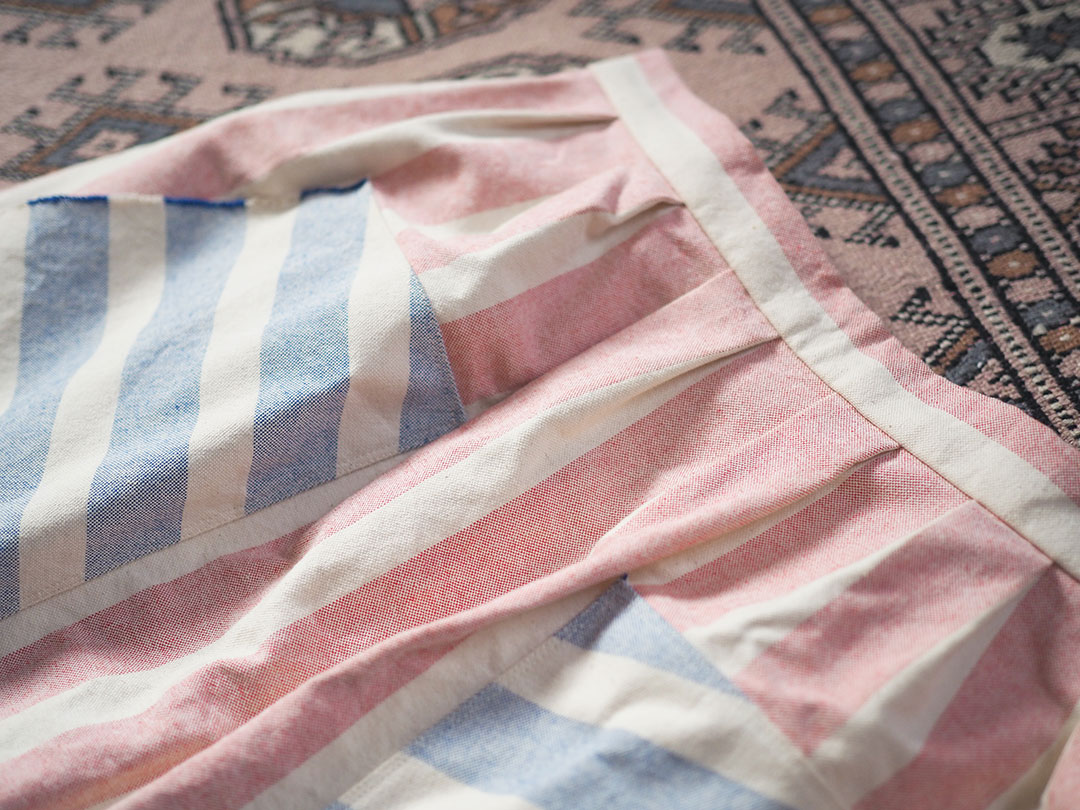
A couple years ago, I sewed a pleated skirt out of duck canvas. It has no drape and is a definite #sewingfail, but it’s queued up to become a pair of shorts in the future!
We all need to make that proverbial dress out of quilting cotton in order to learn.
Ditch your deadlines
I’m only half-joking here, but releasing the pressure of time and performance can help you realize that mistakes aren’t the end of the world. If you make a mistake on your best friend’s wedding dress the day before she gets married, that could be costly. But if you make a mistake on a dress you were hoping to wear on a holiday you were leaving on the next day, you’ll probably survive without it.
Choose projects that let you work on your own timeline. When you let whatever you’re working on take as much time as it needs, mistakes won’t cost you as much. And when you have the luxury of time, success and failure are not binary. There’s no right or wrong, only trial and error, and you can have more than one shot at it.
Still feeling shaky? Choose courage over confidence
If our goal is to better develop our sewing skills, we’re going to be continually stepping out of our comfort zone. I fall victim to analysis paralysis more often than I’d like to admit. I get so wrapped up in choosing a pattern, a fabric, a hack, a style, or even a seam finish, that I don’t get anything done at all. Perfectionism is a form of fear, and I fear that if I don’t choose correctly, I could mess up my project permanently. The reality is, if I had just gone with my first instinct, I could have completed all of the options I had dreamed about.
Sometimes it takes something different from confidence to take the first step—it takes courage.
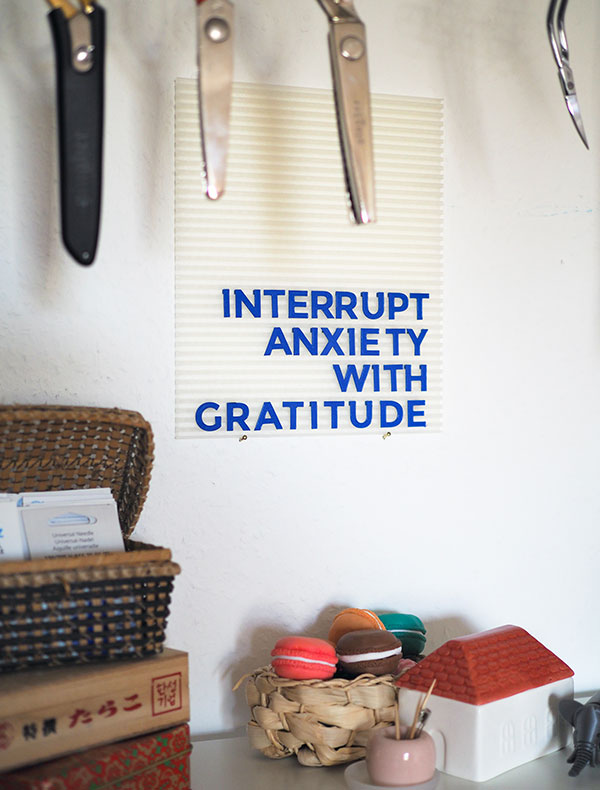
A corner of my sewing studio, with the reminder to be grateful that I’m privileged enough to be able to make mistakes without consequence.
Building confidence through small successes
Sometimes I turn to my husband and tell him I’m proud of myself for X. X can be anything—from trying a new hobby to finishing your first inseam pocket. You can do this to yourself in the mirror or with loved ones. I give you permission to be proud of yourself! It’s okay to share your glories! Bask in your successes!
Think about the last creative project you worked on that you’re proud of. It doesn’t have to be the project as a whole—even a single element of it, like nicely aligned buttonholes or your first not-wonky zipper. Close your eyes. Take deep belly breaths and recount that thing you’re proud of. Give yourself a few moments to really feel that accomplishment from your head to your toes. Smile. You did it! You challenged yourself and accomplished it!
Now, ride that wave of confidence into your next project.

